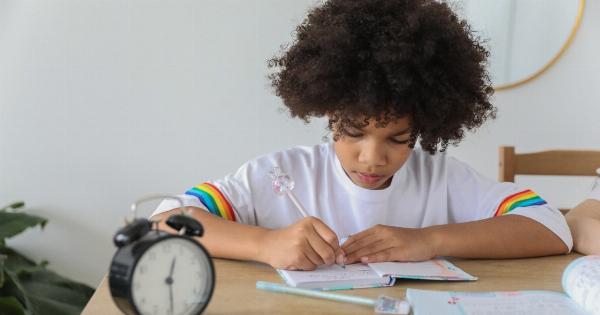Attention-Deficit/Hyperactivity Disorder (ADHD) is a neurodevelopmental disorder that affects children’s ability to pay attention, stay focused, and control impulsive behavior.
It is estimated that around 11% of children worldwide have been diagnosed with ADHD. These children often struggle in a traditional classroom setting, where the teaching methods may not meet their unique learning needs.
The limitations of traditional teaching methods
Traditional teaching methods typically involve a teacher delivering information to a group of students, followed by assignments and assessments.
While this approach may be effective for most students, it can pose several challenges for children with ADHD:.
1. Lack of individualized attention
In a traditional classroom setting, the teacher’s focus is primarily on the entire class, leaving little room for individualized attention.
Children with ADHD may require additional support and guidance to stay on task and absorb the information effectively. Without individualized attention, they may struggle to understand new concepts and retain information.
2. Limited movement and physical activity
Children with ADHD often have excess energy and a need for physical movement. However, traditional teaching methods often require students to sit still for extended periods.
This lack of physical activity can lead to restlessness and difficulty staying engaged in the learning process. It may also hinder their ability to concentrate and process information.
3. Difficulty with sustained attention
Individuals with ADHD often have challenges with sustaining focus and attention.
Traditional teaching methods that rely heavily on lectures or lengthy assignments may overwhelm children with ADHD, causing them to lose interest and become easily distracted. This can hinder their ability to comprehend and engage with the material being taught.
4. Inability to accommodate different learning styles
Children with ADHD have diverse learning styles and may require alternative approaches to absorb and retain information effectively.
Traditional teaching methods often prioritize auditory and visual learning, which can be limiting for children with ADHD. Kinesthetic learners, for example, benefit from hands-on activities and movement, while visual learners may benefit from visual aids and diagrams.
Alternatives to traditional teaching methods
Recognizing the challenges faced by children with ADHD, educators have been exploring alternative teaching methods that better cater to their learning needs. These approaches aim to create a more inclusive and supportive learning environment.
Here are some alternatives to traditional teaching methods:.
1. Differentiated instruction
Differentiated instruction is an approach that recognizes the diverse learning needs of students and tailors teaching methods and materials accordingly.
This method allows educators to adapt the curriculum, content, and assessment methods to match the specific needs and abilities of children with ADHD. By providing individualized instruction, teachers can better engage and support students with ADHD in their learning process.
2. Multisensory learning
Children with ADHD often benefit from multisensory learning experiences that involve multiple senses, such as touch, sight, and movement.
Incorporating hands-on activities, visual aids, and interactive materials can help capture their attention and enhance their understanding of the subject matter. By engaging multiple senses, multisensory learning can significantly improve the learning outcomes for children with ADHD.
3. Collaborative learning
Collaborative learning involves group activities and cooperative tasks where students work together to solve problems and achieve common learning goals. This approach promotes engagement and active participation, which can benefit children with ADHD.
Collaborative learning allows them to interact with their peers, share ideas, and learn from each other’s strengths. The social aspect of collaborative learning also helps build relationships and improve self-esteem in children with ADHD.
4. Incorporating movement breaks
Recognizing the need for physical activity, incorporating movement breaks into the learning routine can be highly beneficial for children with ADHD.
Short breaks that involve stretching, walking, or light physical activities can help release excess energy and improve focus and attention. By allowing movement breaks, educators create a more inclusive learning environment that accommodates the unique needs of students with ADHD.
5. Technology-assisted learning
Incorporating technology into the learning process can be advantageous for children with ADHD. Interactive educational software, online platforms, and educational apps can provide engaging and stimulating learning experiences.
Technology-assisted learning allows children with ADHD to learn at their own pace, provides immediate feedback, and offers interactive elements that cater to their learning preferences.
The benefits of alternative teaching methods for children with ADHD
Implementing alternative teaching methods can result in several benefits for children with ADHD:.
1. Improved engagement and focus
Alternative teaching methods that are designed to be more interactive and individualized enable children with ADHD to stay engaged and focused on the learning material.
By incorporating activities that align with their learning preferences, these methods help maintain their interest and attention throughout the learning process.
2. Enhanced understanding and retention
Alternative teaching methods allow children with ADHD to grasp and retain information more effectively.
By adapting the curriculum and instructional strategies to their specific needs, these methods facilitate a deeper understanding and better retention of the material.
3. Increased self-confidence and motivation
When children with ADHD experience success in their learning journey, it fosters a sense of achievement and boosts their self-confidence.
Alternative teaching methods that encourage collaboration, active participation, and hands-on learning promote a positive learning experience, leading to increased motivation and willingness to learn.
4. Tailored support and individualized learning
Alternative teaching methods prioritize individualized attention and support, which is crucial for children with ADHD.
Teachers can identify the specific strengths and weaknesses of each student, allowing them to provide targeted interventions and personalized learning experiences.
Conclusion
Traditional teaching methods may not work effectively for children with ADHD due to their unique learning needs.
Alternative teaching methods that prioritize individualized attention, multisensory learning, and active engagement have shown positive results in catering to the requirements of these students. By implementing these approaches, educators can create a more inclusive and supportive learning environment for children with ADHD, leading to improved learning outcomes and overall success.





























